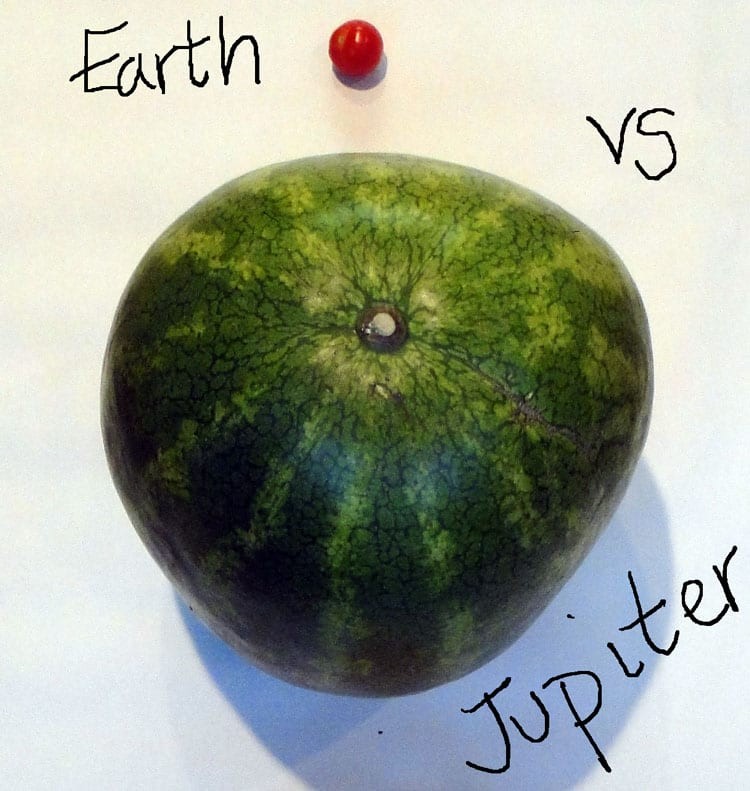Understanding the vastness of space can be challenging, especially for kids. When we talk about planets, it’s easy to list them in order, but grasping their actual sizes relative to each other is a different story. Questions like “How big is Earth compared to Jupiter?” or “Is Mars bigger than Mercury?” are common and show a natural curiosity about the scale of our solar system. This article explores engaging, hands-on methods to help children truly visualize and compare planet sizes, making learning about space both fun and memorable.
3D Planet Size Comparison: The Fruit Basket Approach
Inspired by the brilliant book Professor Astro Cat’s Frontier of Space by Dr. Dominic Walliman and Ben Newman, we discovered a fantastic way to bring planet sizes to life: using everyday fruits and vegetables. The book cleverly uses a scale where planets are represented by different fruits, from a tiny peppercorn for Mercury to a massive watermelon for Jupiter. This 3D approach provides an immediate and tangible understanding of scale that flat images simply can’t replicate.
What makes this fruit comparison method so effective is its physicality. Children can actually see and hold the “planets” in their hands, comparing a cherry tomato (Earth) to a watermelon (Jupiter). This tactile experience solidifies their understanding in a way that simply reading about it cannot. It turns an abstract concept into a concrete reality.
Beyond just size, this method opens up discussions about other planetary characteristics. For instance, while Jupiter is represented by a large watermelon due to its size, it’s crucial to explain that Jupiter is a gas giant. As Professor Astro Cat aptly puts it, “If you tried to land a spaceship on Jupiter, you would fall straight through the surface.” This adds another layer of understanding beyond just physical dimensions, introducing the concept of planetary composition.
Even simple facts, like Mercury being closest to the sun, become more impactful when children realize it’s also the smallest planet, visualized as a tiny peppercorn. This fruit-based model transforms learning about planet sizes from a passive activity to an interactive and engaging experience.
Professor Astro Cat’s Frontiers of Space is a highly recommended resource and is readily available on Amazon.
2D Planet Size Comparison: Drawing Planets to Scale
While the 3D fruit method is excellent for tactile learning, a 2D drawing activity provides another valuable perspective on comparing planet sizes. Creating a scale drawing of the planets allows children to engage their creativity while reinforcing their understanding of relative dimensions. Often, planet diagrams are not to scale, which can be misleading. By drawing them to scale, kids get a more accurate visual representation.
To make this activity accessible, you can use readily available NASA charts that detail the relative sizes of planets compared to the Sun and Earth. These charts serve as excellent reference points for creating your scaled drawings. For smaller planets, a circle template can be helpful, while a compass and ruler are perfect for drawing the larger ones. Older children can even take on the task of calculating the scaled sizes themselves, turning it into a mini-math lesson.
Coloring the drawn planets adds another layer of engagement. Encourage children to research and use accurate colors for each planet, further enhancing their learning experience and attention to detail. Cutting out the planets after drawing allows for physical manipulation and comparison, similar to the fruit method, but in a 2D format.
This drawing method is not only educational but also fosters creativity and fine motor skills. It provides a hands-on, artistic approach to understanding planet size comparison, catering to different learning styles.
Free Printable Planet Size Chart for Your Drawing Activity
To make the drawing activity even easier, we’ve created a free printable chart with planet size measurements in both centimeters and inches. These charts are available in both Letter (US) and A4 paper sizes, ensuring they are accessible no matter where you are.
DOWNLOAD HERE -> How to draw planets of the solar system to scale (Letter)
DOWNLOAD HERE -> How to draw planets of the solar system to scale (A4)
(These printables are for personal and educational use only. Please contact for commercial use inquiries.)
Conclusion: Making Planet Sizes Understandable
Both the 3D fruit comparison and the 2D drawing method offer effective and engaging ways to teach children about comparing planet sizes. These hands-on activities move beyond rote memorization and encourage a deeper, more intuitive understanding of the scale of our solar system. By using familiar objects like fruits or through creative drawing, abstract concepts become tangible and relatable.
Whether you choose to build a fruit-based solar system or create scaled planet drawings, the goal is to spark curiosity and make learning about space an exciting adventure for kids. Encourage your children to explore, compare, and discover the amazing sizes of the planets in our solar system – you might be surprised at what you learn together!

